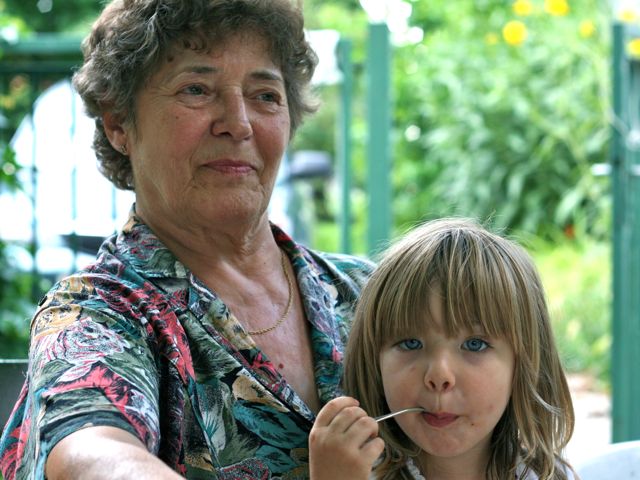
reference-image, l
(article, Carolyn Banfalvi)
I knew nearly nothing about Hungarian food before I moved to Budapest. What I did know is that each dish seemed to require more paprika than I would normally use in a year — no match for the dusty tin of “Hungarian paprika” in my mom’s pantry that had been there throughout my childhood. [[block(sidebar). h1.Featured recipes]] But I had fallen in love with a Hungarian named Gábor, who happened to have a food-obsessed family, and so I got a crash course in Hungarian edibles. I learned how to eat Hungarian style, to really savor the taste of each bite. I learned how to cook the things any decent Hungarian home cook can make without a recipe. But mostly, what I learned about Hungarian cooking I'd call pantry smarts. [%image reference-image float=right width=400 caption="Kati and her granddaughter."] Under the tutelage of my mother-in-law, Kati — who is in the habit of waking at dawn to prepare multi-course lunches from scratch — it was easy to fall in love with this cuisine, which I am now convinced is one of Europe’s most under-appreciated. On my first trip to Hungary, we feasted on lunch at a long table under the chestnut trees in Gábor’s small village in northwestern Hungary. Lunch was never the same thing twice. It always began with a soup, followed by the main course, which was more often than not some kind of pork dish. Salads were served with a salty-sweet dressing, and there was always dessert. “If you don’t like something, you don’t have to eat it,” Kati told me every time, no matter how we raved about her cooking. I’ve been living in Budapest for a decade now, and she still starts her meals with the same unnecessary disclaimer. Gábor’s father was the village doctor and was showered with gifts: freshly killed wild duck, homemade wine, eggs so fresh that they were still covered with feathers, choice cuts of meat, bushels of peppers. Kati knew what to do with it all, putting every scrap to good use. She makes her own jam and condiments, and even her own liquors like green walnut and a creamy egg. She prepares her constant flow of soups, stews, roasts, salads, jams, liqueurs, cakes, cookies, and much more in a kitchen which even most non-cooking Americans would consider severely inadequate. The only counter space is a small kitchen table, the few cabinets are from the 1960s, and the stove and refrigerator look miniature compared to American super-sized models. There are no name-brand knives, and no designer appliances. Kati — hands down the best cook I’ve ever met — doesn’t seem to miss any of that. As it turns out, flashy stainless-steel kitchens aren’t vital for turning out good meals. What you really need are good ingredients, and an understanding of how those ingredients work so you can turn them into the meals that memories are made of. The workhorse of Kati’s kitchen is her pantry. Practically every Hungarian kitchen has a walk-in pantry, and Hungarians are zealous canners during the summer, lining their pantry shelves with goodies to eat during the long winter months when root vegetables dominate the markets. This pantry is practically her only storage space, and lined as it is with rows of unlabeled bottles and jars, it exudes an air of mystery. It is clearly Kati’s territory. Even now, I feel like an intruder when I take a peek inside. By tasting her food and watching her in the kitchen, I’ve learned most of what I know about Hungarian cooking. This food is what drew me into the family, despite the language barrier. When I got my own Budapest kitchen, I began making batches of lekvár (jam), pots of lecsó (pepper and tomato stew), rendered lard, stuffed peppers, and spaetzle. My two little daughters are starting to love Kati’s cooking as much as the rest of us do. They already know that Hungarian dishes made by her are the gold standard. My pantry is slowly filling up with various jars and bottles. The Hungarian influence has even spread to my mother’s kitchen in Washington, D.C. Her paprika no longer just gathers dust in the pantry; she now knows how to use it, and she uses it often. Is this the way everyone cooks in Hungary? No; most younger Hungarians do not cook the way that Kati's generation does. They do not cook as much in general, and I think the cooking style is changing; they are more interested in food that's lighter than the traditional Hungarian food, and they are also discovering ingredients that their parents did not have access to. So it's difficult to know the future of Hungarian cuisine. For now, though, I'm eating it up. p(bio). Carolyn Bánfalvi is a writer based in Budapest. She is the author of the culinary guidebook Food Wine Budapest, and she leads food, wine, and market tours through her bespoke tour company, Taste Hungary.

reference-image, l